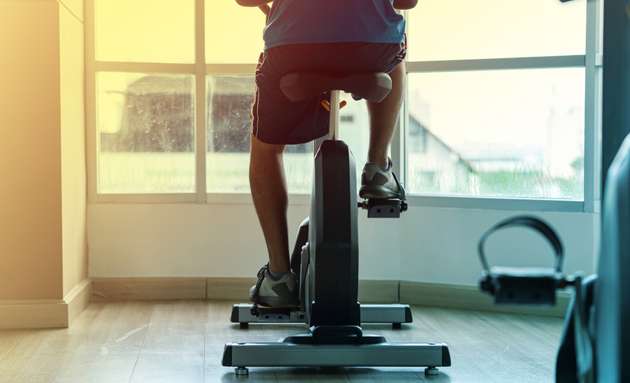HIIT - What Does it Mean and What it Does

Are you among the 64% of Indians who hardly get any exercise?
A recent study showed that less than 10% of Indians between the ages of 25 and 40 engage in any kind of recreational physical exercise. Mostly because of lack of time.
Despite knowing that exercise is good for our health, we are hardly able to put it to practice. With erratic work hours and traffic eating into our time, it becomes difficult to plan and stick to any workout routine. However, all hope is not lost.
When you’re short on time and heading to a gym does not seem like a practical idea, try opting for a high intensity interval training workout at home. For those who don’t know what high intensity interval training is, read on to learn more.
What Exactly Is High Intensity Interval Training (HIIT)?

High Intensity Interval Training, or HIIT is a form of workout regime that alternates short periods or bursts of intense aerobic exercises with short spells of rest. HIIT is also known as high intensity intermittent exercise or sprint interval training, and typically involves exercise methods like weight training, strength exercises, cycling, swimming, running, or walking. HIIT can be performed anywhere and can be modified to suit people of all fitness levels and medical conditions.
Is HIIT the Most Efficient Way to Work Out?

Despite lasting for anywhere between 10 to 30 minutes, high intensity interval training has a lot of benefits. Here are 5 reasons why HIIT is one of the most effective workout regimes there is.
1. It burns a lot of calories in a short amount of time

A high intensity interval training workout burns 25-30% more calories than any other form of exercise. HIIT leads to a metabolic upsurge that results in faster calorie-shedding, lower insulin resistance, improved heart function, and better endurance levels. It helps burn more fat effectively in less time, and is thereby a choice for most weight loss routines.
2.Your metabolic rate stays high even after exercising
Because of the intensity of this kind of workout, it can result in the body burning a lot of calories at a higher rate even after 48-72 hours of your high intensity interval training workout. This is because your body is trying to replenish the lost nutrients like carbohydrates and electrolytes during your HIIT workout. A study conducted on HIIT found that the body’s metabolism shifted towards using fat for energy rather than carbohydrates after an HIIT workout, thereby enabling you to lose weight more effectively.
3.You might gain muscle using HIIT

HIIT not only helps you burn calories faster and reduce weight, but it also aids in building muscle mass. This is especially true for people who have been leading inactive lifestyles. However, if you’ve been involved in weight training, you may not see as much increase in muscle mass as you would have experienced previously.
4.HIIT may improve your oxygen consumption
Oxygen consumption means your muscles’ ability to use oxygen while exercising. HIIT may help improve your muscles’ oxygen consumption in a short span of time, as opposed to endurance training that is typically employed to improve your oxygen consumption. One study states that performing HIIT workouts 4 days per week for 20 minutes over 5 weeks improved oxygen consumption by 9% in participants.
5.HIIT may help reduce heart rate, blood pressure, and blood sugar

HIIT can reduce insulin resistance, thereby keeping your blood pressure and blood sugar levels in check. However, this may be applicable to people who are overweight or obese,or Type 2 Diabetes, and not for individuals with normal weight and blood pressure.
Similarly, HIIT is also known to improve heart function. A study in 2017 found evidence of the effectiveness of HIIT on heart health in patients with heart conditions. However, more research is underway to find the exact link between heart health and high intensity interval training workouts.
Can You Do HIIT With a Medical Condition?
Exercising is an imperative part of managing medical conditions like type 2 Diabetes, hypertension, high cholesterol, or heart disease. However, it is advisable to not jump into HIIT without consulting your doctor first.
HIIT puts a lot of effort on your heart, because of the intense bursts of workout. So, if you already have a heart condition, check with your doctor to know if it’s suitable for you, and start at a slow pace until you build your tolerance.
Similarly, you may not be able to do HIIT if you have muscle and joint problems like arthritis.
If you’re pregnant, your growing belly might be a hindrance to HIIT. Check with your gynaecologist before you opt for HIIT while pregnant, especially in your second and third trimesters.
How Can You Do HIIT at Home?

Always remember, more is not always better for results. If you’re a beginner at high intensity interval training workout, start gradually - 1-3 days per week. Begin with choosing your preferred activity - be it cycling or squat jumps. Then you can start experimenting with different durations of exercise and rest until you feel comfortable with the pace. You can,
- Use a stationary bike and pedal as fast as you can for 30 seconds. Follow this up with a slow pedal for 2 to 4 minutes and repeat this pattern for 10 to 20 minutes.
- Do squat jumps as quickly as possible for 30-90 seconds and then walk for another 30-90 seconds. Repeat this for 10 to 20 minutes.
- You can also try circuit training - a workout regime that involves a series of exercises with no periods of rest in between.
- Do body weight exercises like push ups, lunges, step ups, and squat jumps to make your own regime according to your needs.
As much as we would want to take care of our health and lead an active lifestyle, more often than not, it isn’t possible. However, if we look at the benefits of high intensity interval training, its efficacy is far more than the efforts required. If you’re looking at losing weight or improving your overall fitness, high intensity interval training may just be what you’re looking for.






